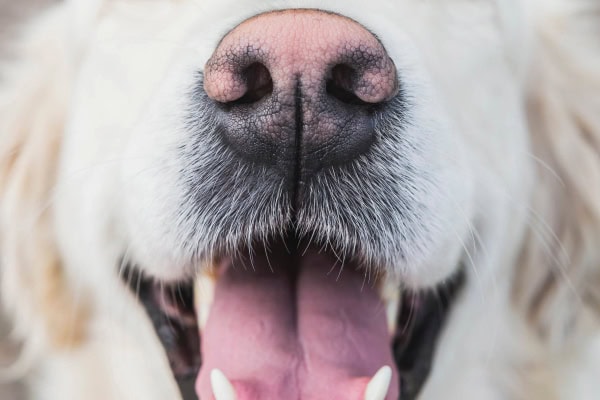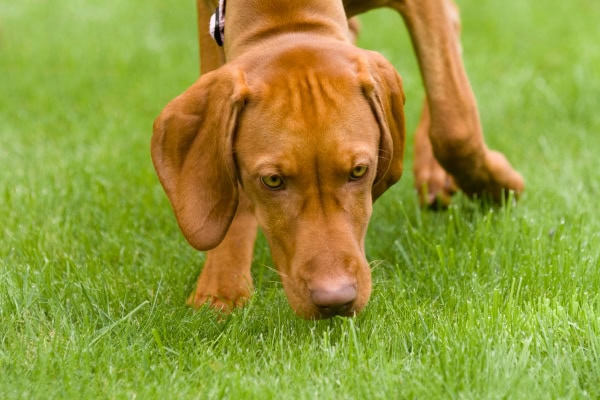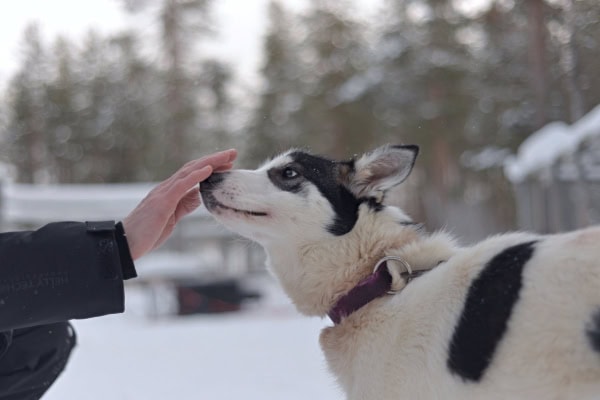Does a dog’s cold nose mean he or she is healthy? Or is this just a myth? Integrative veterinarian Dr. Julie Buzby sniffs out all the facts about what dogs’ noses can—and can’t— tell us. Read on to discover why your dog’s nose might be cold and if dogs’ noses should be cold.

One of the oldest old wives’ tales out there is that if a dog’s nose is warm and dry, he or she is sick.
I remember hearing this as a child and accepting it as fact. I’d regularly feel my dog’s nose the way a parent might feel their child’s forehead if they suspect a fever. And if it was warm and dry I’d start to worry.
However, as a veterinarian with over 25 years of experience, I wish I could go back and tell my younger self that there are far better indicators of sickness or health than the temperature of a dog’s nose.
So what does it mean when a dog’s nose is cold?
Why are dogs’ noses cold?
As it turns out, there are several very good reasons dogs have cold wet noses.
Regulating body temperature
Dogs can’t sweat as much as we can (only through their feet), so they have other, more effective ways to regulate their body temperature. Dogs pant and lie on cool surfaces as their predominant ways of cooling off. But it is possible that dogs’ noses could help them control their body temperature too.
When a dog licks his or her nose, this adds a thin film of moisture from the saliva to the surface of the nose. As that moisture evaporates, it takes body heat with it, leaving behind a cooler nose and a cooler dog.
Due to the small size of the nose compared to the whole dog, it isn’t clear at this point how much this process contributes to overall cooling. But when it comes to decreasing the risks of the dog overheating or worse yet, developing heat stroke in dogs, every little bit helps.
Increasing the sense of smell
Dogs often approach the world nose-first. Their keen sense of smell gives them a lot of information about their surroundings. In fact, the part of dogs’ brains devoted to their sense of smell is about 40 times larger than ours. This means they can smell somewhere between 10,000 and 100,000 times better than people.

Interestingly, when a dog’s nose is wet, their sense of smell is even better! This is the case because tiny scent particles can stick better to the surface of a moist nose.
Dogs use a combination of two methods to keep their noses cool and wet for optimal sniffing.
- Dogs have mucous-producing glands in their noses that work to keep the inside of the nose moist. Some of this clear, watery mucous drips out of the nostrils and onto the surface of the nose. It moistens the surface of the nose to allow scent particles to stick to it better. (Plus, some of this liquid evaporates to help with cooling.)
- The other method is dogs licking their noses. The saliva on the tongue moistens the surface of the nose and cleans it off. Plus, licking the nose disperses those little drops of mucous. And it draws scents to the roof of the dog’s mouth where more tissue for detecting scents is located.
Seeking heat
A recent study published in Nature discovered that the noses of carnivores are cooler than those of herbivores. Plus, it showed dogs are able to use their noses to detect heat waves (weak thermal radiation) from a distance. The heat signals used in the study were similar to those that may be given off by prey.
Also, researchers discovered that the portion of the brain that lights up on an functional MRI in response to weak thermal radiation is the same part used for processing information about food and targeting an object. This data points to the potential that a dog’s cold nose once helped him or her hunt prey in the wild by sensing heat.
Should a dog’s nose be cold?
Usually, a dog’s nose should be somewhat cold and wet in most situations. As you have learned, that cold wet dog nose has a purpose. However, the degree of coldness and wetness can vary. And sometimes the nose will feel dry or warm instead without it being a cause for concern.
How do you know if a dog with a cold or warm nose is sick?
When looking at the list of reasons dogs have a cold nose, you will notice that none of them have much to do with your dog’s health status. So a cold wet nose doesn’t guarantee your dog is healthy. And just because your dog’s nose feels warm and dry doesn’t mean he or she is sick.

For example, dogs noses can get dry while they sleep or if they haven’t licked their nose in a little while. Plus, low humidity or not drinking enough water after hard exercise can also lead to a warm dry nose. On the flip side, dogs can have a cold wet nose and still have diabetes in dogs, Cushing’s disease in dogs, or a host of other conditions.
Therefore, if your dog’s nose isn’t the temperature you think it should be and you are worried about him or her, remember to look for other signs of illness before jumping to any conclusions. Nose temperature isn’t a reliable indicator of health. But these other symptoms may help you tell if your dog is sick:
- Nasal discharge (runny nose)
- Excessive sneezing
- Dog coughing and gagging
- Difficulty breathing
- A lethargic dog or changes in exercise tolerance
- Vomiting
- Diarrhea
- Changes in appetite
- Decreased or increased thirst in dogs
- Changes in urine volume
If you notice any of these signs, call your vet. He or she will be able to advise you best about how to proceed.
Rely on your vet and your dog parent intuition, not your dog’s nose temperature
Dogs noses are amazing in many ways, but being a “dog health detector” isn’t one of them. While a cold, wet nose is the norm in most dogs, a warm and/or dry nose doesn’t necessarily mean doom and gloom. It can be completely normal too!
So go ahead and boop that snoot without worry that it may be sending covert messages about your dog’s health. And remember that when it comes to canine health questions, your vet and your intuition—not your dog’s nose temperature—are your best guides.
Does your dog usually have a cold wet nose?
Please comment below.


We welcome your comments and questions about senior dog care.
However, if you need medical advice, diagnosis, or treatment, please contact your local veterinarian.